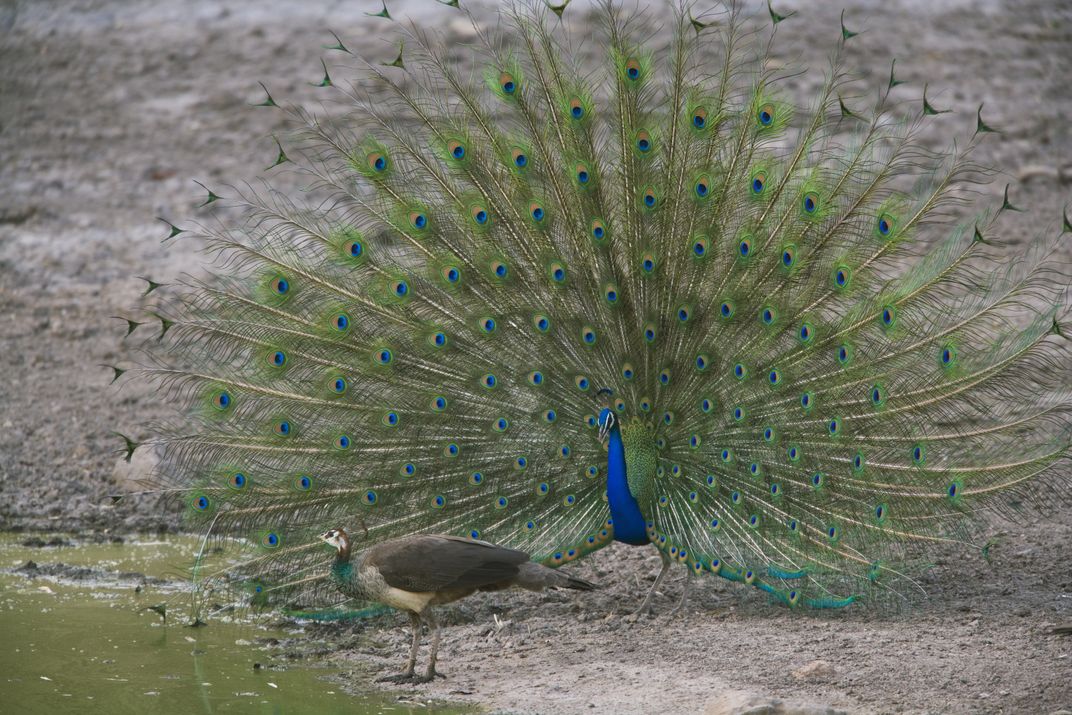Drab Female Birds Were Once As Flashy As Their Male Mates
Biologists always assumed that sexual selection primarily drove differences in looks between male and female birds, but a new study challenges that notion
:focal(1852x682:1853x683)/https://tf-cmsv2-smithsonianmag-media.s3.amazonaws.com/filer/16/8d/168d6e4d-fe80-4384-8d73-3216fe94b5e2/blackbird.jpg)
Gaudy birds—from peacocks to birds of paradise to pheasants—strut their stuff in zoos, parks and forests around the world, drawing ooohs and ahhs over their impressive aesthetics. What the most of these bodacious species have in common is that the brightest and most beautiful among them are the males. Females, on the other hand, are drab, mutely colored creatures, easily overlooked next to their flashy mates.
This state of feathery affairs presents a chicken-or-the-egg evolutionary conundrum: did males evolve into the beautiful creatures we appreciate today to attract females, or did females somehow lose their flare over the eons because they didn’t need it to survive?
Starting with Charles Darwin and his theory of sexual selection, biologists have long assumed the former situation primarily applied when it came to visually driving the sexes apart. Females demanded more and more of their mates, egging them on to greater evolutionary heights of rainbow color, impossibly proportioned ornaments and razzle-dazzle displays.
According to new research published in the journal Evolution, however, that was not necessarily the case. Females, it seems, were once flashy, too, but over the years evolution drove them toward a drabber plumage.

To give females their evolutionary due, the authors focused in on 37 species of birds from a group called New World blackbirds. This group includes garden-varieties such as grackles and red-winged blackbirds. Some of those species have the typical bright-male-dull-female dichotomy, while others possess an equally beautiful plumage between the sexes. The researchers collected three pristine specimens of both gender from each species, which they sourced from various museum collections.
On each bird, they took 22 detailed measurements of various feather patches using a special spectrometer, and then applied those readings to a complex mathematical model called the Vorobyev-Osorio model, which is commonly used to make inferences about things like visual ecology and color perception. This allowed them to standardize and compare colors between the sexes and within and between bird species according to how birds perceive color rather than how people see it.
Next, they used a phylogenic tree based on DNA sequence data to map the species’ evolutionary history by gender. In other words, the researchers used a genealogy of relationships among species to trace back the rates of plumage color evolution in males and females. Finally, they compared those results with modern day differences between the sexes to piece the entire story together.
Males and females, they found, oftentimes both began from the same brightly colored starting point. But the females’ rate of evolutionary change tended to outpace their male counterparts, allowing the fairer sex of many species to, well, lose their "fairness" and quickly shed their color, while males evolved at a slower step toward more gaudy patterns. Overall, the females’ rapid rate of change significantly played into the differences between the sexes.
So what does this mean? While male color evolution is largely driven by sexual selection—ladies’ choice, in other words—female evolution, the researchers think, is more strongly controlled by natural selection, including predation, survivorship and the ability to rear successful young. Under those pressures, the researchers think, during delicate periods such as nesting, females that blended in with the brush had the evolutionary edge than ones that were bright purple or yellow. The team suspects that these results extend to other species, as another recent study on Australian fairy wrens arrived at a similar conclusion.
This means that sexual selection can’t receive full credit for driving the visual differences between males and females. Darwin, the researchers think, would have been surprised. “Our findings show that, regardless of how showy a male's traits are, the differences between the sexes in these traits are driven mostly by evolutionary changes in female,” said J. Jordan Price, a biologist at St. Mary’s College of Maryland and lead author of the study, in an email. “To understand current patterns of diversity in birds, we need to pay more attention to the females, regardless of how eye-catching the guys appear.”
In other words, females’ dull colors are the product of a beautifully complex evolutionary history. They shed their flashy plumage because they didn’t need it to mate, whereas males continued to be dandies to ensure the longevity of their lines. A lesson, perhaps, for ladies everywhere.
/https://tf-cmsv2-smithsonianmag-media.s3.amazonaws.com/accounts/headshot/Rachel-Nuwer-240.jpg)
/https://tf-cmsv2-smithsonianmag-media.s3.amazonaws.com/accounts/headshot/Rachel-Nuwer-240.jpg)